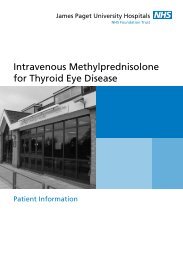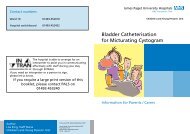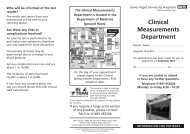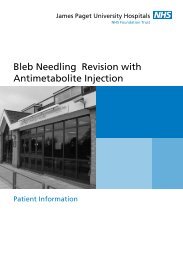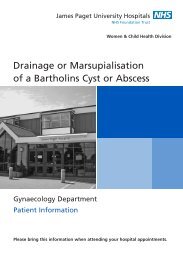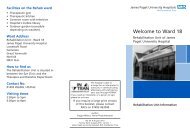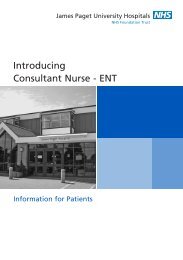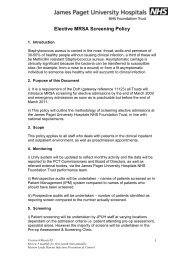Quality Account 2010/11 - James Paget University Hospitals
Quality Account 2010/11 - James Paget University Hospitals
Quality Account 2010/11 - James Paget University Hospitals
Create successful ePaper yourself
Turn your PDF publications into a flip-book with our unique Google optimized e-Paper software.
Monthly CVC BSI Rates<br />
14<br />
12<br />
Rate of CVC BSI 1000 Catheter days<br />
10<br />
8<br />
6<br />
4<br />
Series1<br />
2<br />
0<br />
Dec-09 Jan-10 Feb-10 Mar-10 Apr-10 May-10 Jun-10<br />
Jul-10 Aug-10 Sep-10 Oct-10 Nov-10 Dec-10 Jan-<strong>11</strong> Feb-<strong>11</strong> Mar-<strong>11</strong><br />
Surviving Sepsis is a campaign that has been introduced to reduce mortality and morbidity<br />
associated with delays in recognition and treatment of sepsis. If not treated in a timely way,<br />
sepsis can become a medical emergency. Evidence suggests that a specific bundle of care<br />
interventions, initiated at point of diagnosis improve patient outcomes. The Trust focus at the<br />
current time is to improve sepsis recognition. Initiation treatment is being focussed on A&E<br />
and EADU. Plans are in place to roll out the ‘sepsis bundle’ throughout the Trust this year.<br />
Surgical Site Infection Surveillance is mandatory, with periodic surgical site surveillance<br />
undertaken following hip and knee joint replacement surgery. Results issued last year report<br />
that over the preceding five year period the following infection rates were seen:<br />
• national average for hip replacement 1.1% (JPUH = 1.2%)<br />
• national average for knee replacement 1.1% (JPUH = 1.3%)<br />
Some changes to practice have been implemented that should further improve wound care in<br />
the orthopaedic areas.<br />
World Health Organisation (WHO) Surgical Safety Checklist - In England and Wales,<br />
129,419 incidents relating to surgical specialities were reported to the NPSA from 1 st January<br />
– 31 st December 2007. The WHO Surgical Checklist is designed to reduce the number of<br />
errors and complications resulting from surgical procedures. There are ten core standards<br />
that WHO recommend should remain, even if local adaptation to the checklist is made. At the<br />
<strong>James</strong> <strong>Paget</strong> we have integrated the checklist into our electronic theatre information system<br />
and have introduced a visual prompt in each. Audit results from October <strong>2010</strong> to March 20<strong>11</strong><br />
demonstrate that more than 99% of the checklist has been appropriately completed.<br />
<strong>James</strong> <strong>Paget</strong> <strong>University</strong> <strong>Hospitals</strong> NHS Foundation Trust<br />
<strong>Quality</strong> <strong>Account</strong> <strong>2010</strong>/<strong>11</strong> Page 36 of 62





